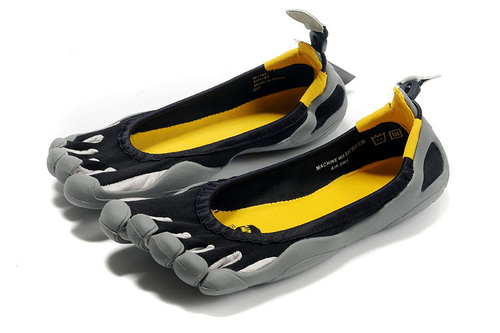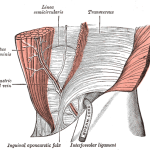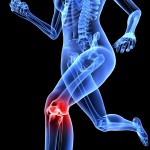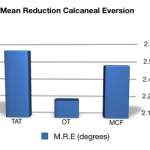Introduction
The shoe industry has evolved most rapidly over the previous decade and will continue to evolve as new technologies and markets are formed. We are in an era where athletes are training in barefoot running shoes and it’s not uncommon for a shoe to carry a microprocessor to play music and/or retain information for further gait evaluation post training. This article aims to unravel the hype and assist physiotherapists on advising the most appropriate footwear for their patients.
Why Do We Wear Running Shoes?
The primary purpose of a shoe is to protect the foot; a shoe however also has the potential to change lower limb/foot function (1). Due to the relationship between footwear and pathology, health professionals have a responsibility to consider footwear characteristics in the etiology and treatment of various patient presentations (2). A correctly prescribed shoe can assist with healing rates, improve mobility and reduce injury risk of the lower limb (3). In the United Kingdom foot and ankle problems account for approximately 8% of musculoskeletal consultations in primary care (4). Whilst further investigations are often required for foot and ankle pathology the correct shoe is an easily accessible intervention for early management of symptoms.
What Are The Key Features Of A Shoe?
A shoe can have the greatest biomechanical affect on the rearfoot- ankle and subtalar joints, midfoot – midtarsal joints and the metatarsals at the forefoot (5). The key features of a shoe include the heel counter, density and placement of foams on the medial sole (6), shoelace system and forefoot rocker angle. These shoe prescription variables have the greatest potential to influence gait and are taken into consideration when choosing a shoe for particular foot posture and foot/ankle pathology.
Summer footwear, which includes the use of ‘open back’ slip-on footwear, increases the incidence of achilles and calf muscle pathology (7). Early intervention strategies such as changing attitudes to appropriate footwear can help reduce the risk of this common injury and commence early treatment for pathological patients. The sandal with adjustable rearfoot, midfoot and forefoot straps is advisable for patients wanting to wear a summer shoe. This will ensure the main anatomical foot structures are in a position of optimal functional efficiency.
Footwear Prescription: What Is The Gold Standard?
The gold standard of footwear prescription is the running shoe. The spectrum of functional components does not present in any other other shoe category. Whether the foot requires pronatory control, pressure reduction or improved sagittal plane motion there is a running shoe on the market that can cater for this (8).
It has been generally accepted throughout the allied health and retail communities that footwear prescription comes in 3 categories; motion control, stability and neutral. However recent research has challenged this prescription process (9). In my opinion, running shoes should be prescribed based on the persons functional foot posture and injury history.
If a patient does not run on a regular basis, running shoes can still be prescribed for the pathological foot. When foot pathology presents to general practice an appropriate running shoe can be recommended for use as a first line treatment. Advice may be for the patient to wear their appropriate running shoes for the majority of weight-bearing time till further investigations, diagnosis or referrals have been implemented.
The Role of Cushioning
During running the body experiences an initial peak force of between two and three times the persons body weight (10). During the 1980s running shoes were marketed with suggestions that the primary goal was to reduce initial peak force (11). Research over a decade later revealed that shoes to not reduce the initial peak force (12)!
Cushioning materials are marketed very heavily in today’s running shoes. Whilst we cannot affect the initial peak force with cushioning material alone we can however slow down the rate at which force is applied to the body and reduce pressure on the sole of the foot by 17-33% (14) – important variables to consider when prescribing shoes for our patients.
When Should You Replace Footwear?
Generally, a running shoe will last between 800-1200km (15). For the regular walker and runner this equates to approx 9-18 months. The materials in running shoes are not overly durable. After running just 500km foot pressure can increase by as much as 100%. The foams used in footwear manufacture are closed cell, once ruptured can never return to original form. These ruptured compression lines are visible, it is recommended to update the shoe once these lines are first noticed.
Signs of a worn out shoe include firmness under foot, reduced cushioning, significant wear on the upper and/or wear through the outsole. Some runners find it useful to alternate a second pair of running shoes – which will help improve the durability.
Barefoot Running Shoes – The Bare Essentials
Since the release of the Nike Free shoe in 2006 the barefoot running shoe market has been growing. A barefoot running shoe can be prescribed for the athlete wanting to improve intrinsic foot muscular strength or as an aid to assist running efficiency (17). Care has to be taken when recommending these shoes to pathological general populations.
The risks associated with the use of barefoot running shoes include overuse musculoskeletal conditions of the foot and ankle specifically tendonitis and tendinopathies of the achilles and tibialis posterior tendons (18). The forefoot is also susceptible to pressure type pathologies such as capsulitis, bursitis and metatarsalgic symptoms. An increase in forefoot load may also lead to early degenerative arthritis particularly of the 1st metatarsal head (19). It is a matter of weighing up how susceptible your patient is to these types of injuries and working together whilst maintaining open communication to achieve the desired outcome.
There have been suggestions that barefoot running shoes contribute to a higher incidence of midfoot ground contact during gait; midfoot ground contact (as opposed to initial heel contact or forefoot contact) has been shown to be the most efficient strike pattern whilst running (20). Barefoot running shoes can assist, however are not necessary to achieve this.
In my opinion a barefoot running shoe should be prescribed for the elite running athlete with sound medical history looking to modify gait patterns to achieve a desired outcome. In my opinion barefoot running shoes should only be worn for a minority (10-15%) of training and monitored closely by their health professional/ coach.
Conclusion
The running shoe will certainly continue to evolve. We have a responsibility as health professionals to keep up with the new technology in order to achieve the most desirable outcomes for our patients. However we also have a responsibility not to lose our perception in the hype and marketing surrounding running shoes.
About The Author
This was a brilliant guest post written by Sports Podiatrist Trent Salkavich. Trent is the director of SportsPodiatrists.com.au and consults from Sydney Sports Medicine Centre, Balmain Sports Medicine and Sydney Sports Med Specialists. He is currently the consulting podiatrist for:
- Australian Defence Force Academy Barracks
- Sydney Apia (formally known as the Medibank) International Tennis Tournament
- NSWIS/AIS Tennis players
- Various AUS/NSW Institute of Sport – athletes
- Australian Wallabies 2011 World cup team
Trent has considerable experience working with elite level athletes and also integrating with other members of the allied health team including sports physiotherapists. We were fortunate enough to have him provide his advice and expertise in this area.
Even better: he is going to do a podcast interview for you! Look for that next week.
What Are Your Thoughts?
What are your thoughts on the use and prescription of various running shoes? Do you find it has anecdotal evidence or is it just brilliant marketing? I would love to know your thoughts be sure to let me know in the comments or catch me on Facebook or Twitter.
Are you a physiotherapist or physical therapist looking to promote your own clinic, check this out.
References
1. Changes in running kinematics and kinetics in response to a rockered shoe intervention. Boyer KA, Andriacchi TP. Clin Biomech (Bristol, Avon). 2009 Dec;24(10):872-6. Epub 2009 Sep 9.
2. Development and evaluation of a tool for the assessment of footwear characteristics. Christian J Barton1,2*, Daniel Bonanno2,3 and Hylton B MenzJournal of Foot and Ankle Research 2009, 2:10
3. Interaction of arch type and footwear on running mechanics. Butler RJ, Davis IS, Hamill J. Am J Sports Med. 2006 Dec;34(12):1998-2005. Epub 2006 Aug 10
4. Characteristics of primary care consultations for musculoskeletal foot and ankle problems in the UK. Hylton B. Menz, Kelvin P. Jordan, Edward Roddy and Peter R. Croft.Rheumatology 2010;49:1391–1398 doi:10.1093/rheumatology/keq092 Advance Access publication 19 April 2010
5. Torsion –a new concept in construction of sports shoes. Motion excursion of the foot in athletic stress–anatomical and biomechanical observations and their effects on construction of sports shoes].Segesser B, Stüssi E, von A Stacoff M, Kälin X, Ackermann R. Sportverletz Sportschaden. 1989 Dec; 3(4):167-82.
6. Midsole material-related force control during heel-toe running. Kersting UG, Brüggemann GP. Res Sports Med. 2006 Jan-Mar;14(1):1-17.
7. Disorders of the Achilles tendon and its insertion Review Article. Clinics in Podiatric Medicine and Surgery, Volume 22, Issue 1, January 2005, Pages 87-99 Enzo J. Sella
8. Athletic footwear, leg stiffness, and running kinematics. Bishop M, Fiolkowski P, Conrad B, Brunt D, Horodyski M. J Athl Train. 2006 Oct-Dec;41(4):387-92.
9. Knapik JJ, et al. (2010). Am J Prev Med, 197-211
10. Cavanagh DE Lafortune MA (1980). J Biomech. 13, 397-406
11. Nigg BM, et al (1988). J Biomech, 20, 951-959
12. De Wit B, et al (2000). J Biomech, 33, 269-278
14. Wegener C, et al (2008). Am J Sports Med, 36, 2139-2146
15. Verdejo R & Mills NJ, (2004). J Biomec, 37, 1379-1386.
17. Knapik JJ, Feltwell D, Canham-Chervek M, et al. 2001. Evaluation of Injury Rates During Implementation of the Fort Drum Running Shoe Injury Prevention Program. Aberdeen Proving Ground, MD: US Army Center for Health Promotion and Preventive Medicine. 12- MA-6558-01.
19. Snel JG, Delleman NJ, Heerkens YF, van Ingen Schenau GJ. Shockabsorbing characteristics of running shoes during actual running. In: Winter DA, Norman RW, Wells RP, Hayes KC, Patla AE, eds. Biomechanics IX-B. Champaign, Ill: Human Kinetics Publishers; 1985: 133-137.
20. Hesar NGZ, Ginckel AV, Cools A, Peersman W, Roosen P, De Clercq D, Witvrouw E. A prospective study on gait-related intrinsic risk factors for lower leg overuse injuries. Br J Sports Med 2009;43:1057-1061
Photo Credit: CJ Sorg, Lou Tamposi
Related Posts
Trackbacks













[…] The Running Shoe: Excellent Science or Excellent Marketing? – Great article about popular running footwear. I think we all get this question a lot, “should I get a certain type of shoe”. The right shoe can make a significant difference in patient’s function. […]